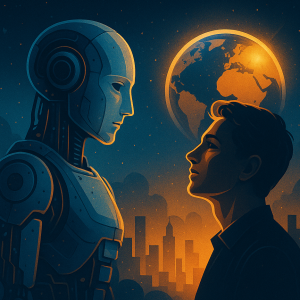
Artificial Intelligence (AI) and Machine Learning (ML) are no longer futuristic buzzwords—they’re actively redefining how we build, deploy, and scale modern software. Whether you’re a developer, data scientist, or tech entrepreneur, understanding the evolving AI landscape in 2025 is essential to staying competitive.
In this blog, we’ll explore what’s new, what matters, and how to get hands-on with AI/ML today.
🧠 Why AI/ML Is Still the Hottest Tech Trend in 2025
AI is disrupting every industry—from healthcare and finance to gaming and education. According to Gartner, enterprise AI adoption has jumped 40% YoY. The real game-changer? Open-source models and accessible cloud APIs are making AI development easier than ever.
🚀 5 Key AI/ML Trends You Should Know
1. LLMOps Is the New MLOps
Managing large language models (LLMs) like GPT-4, Claude, or Mistral requires tools beyond traditional ML workflows. Enter LLMOps—an emerging discipline focused on:
- Prompt lifecycle management
- Custom model fine-tuning
- Evaluation and monitoring of LLMs in production
👉 Tools to explore: LangChain, LlamaIndex, Weights & Biases, PromptLayer
2. Open-Source AI Models Are Going Mainstream
While OpenAI and Anthropic still dominate, open-source models like LLaMA, Mistral, and Mixtral are gaining serious traction.
💡 Tip: Hosting your own LLM using tools like Text Generation WebUI or Hugging Face Transformers gives you privacy and full control.
3. Edge AI: From Hype to Reality
Running ML models on edge devices (like Raspberry Pi, smartphones, or IoT hardware) has improved with frameworks like:
- TensorFlow Lite
- ONNX Runtime
- Edge Impulse
Use case: Real-time image recognition for smart factories and agriculture.
4. Multimodal AI: Beyond Text and Images
Multimodal models that understand text + image + audio (like GPT-4 Vision or CLIP) are changing how we design interfaces and data flows.
Use this to build:
- AI copilots with visual input
- Voice-enabled customer service bots
- Augmented reality (AR) assistants
5. Generative AI APIs Are the New Dev Tools
With APIs like:
You can now:
pythonCopyEdit# Example: Chat Completion using OpenAI
import openai
openai.api_key = "your-api-key"
response = openai.ChatCompletion.create(
model="gpt-4",
messages=[
{"role": "user", "content": "Summarize the concept of Reinforcement Learning"}
]
)
print(response['choices'][0]['message']['content'])
🛠️ How to Get Started with AI/ML (Even If You’re New)
Here’s a step-by-step roadmap:
- Start with Python: Learn the basics of Python, NumPy, Pandas, and scikit-learn.
- Take a Practical ML Course: Try fast.ai or Andrew Ng’s ML Specialization.
- Build Projects:
- Image classifier using TensorFlow
- Chatbot using Hugging Face Transformers
- Stock price predictor with XGBoost
- Join the AI Dev Community:
- Reddit: r/MachineLearning
- Discord: OpenAI or LangChain communities
- GitHub: Contribute to open-source AI repos
📚 Must-Know Resources
| Category | Resource |
|---|---|
| Docs & APIs | OpenAI Docs, Hugging Face |
| Books | “Hands-On ML with Scikit-Learn, Keras, and TensorFlow” |
| Tools | Colab, Jupyter, MLflow, DVC |
| Tutorials | freeCodeCamp AI playlist |
🧩 Open Questions for the Community
- Will open-source models outperform proprietary LLMs by 2026?
- What’s your take on the ethics of AI-generated content?
- How are you using AI/ML in your personal or work projects?
💬 Drop your thoughts in the comments! Let’s build the future, together.
🔄 TL;DR
- AI/ML is still booming—especially LLMOps, edge AI, and generative APIs.
- You don’t need a PhD to get started—Python, free courses, and hands-on projects are your best friends.
- Stay curious, experiment often, and share what you learn.
